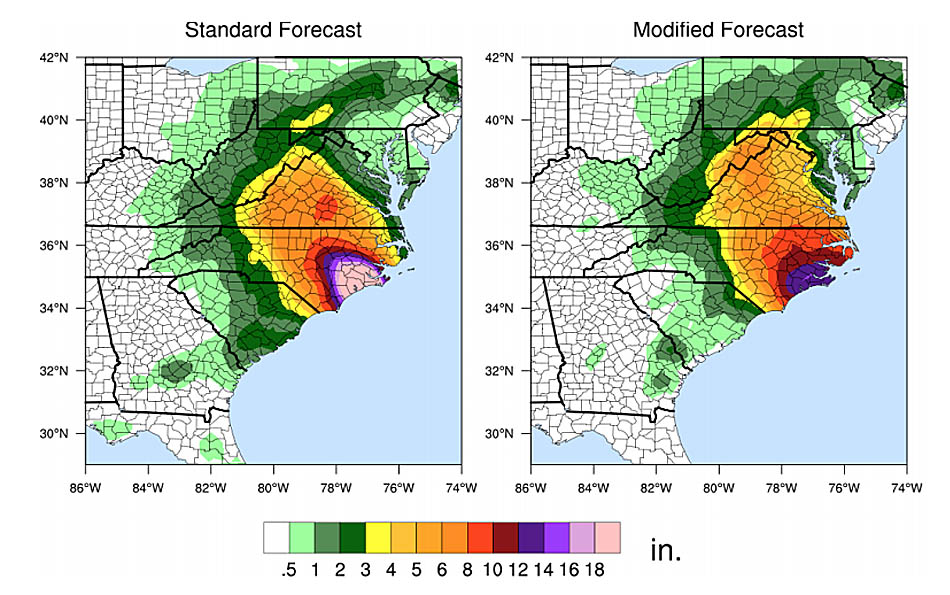Attributing the impact of climate change on Florence in near real time
Experimental technique seeks to forecast hurricanes minus the climate change
Sep 18, 2018 - by Laura Snider
Sep 18, 2018 - by Laura Snider

Ensemble average forecasts for accumulated rainfall from Hurricane Florence using standard meteorological initial conditions (left) and those same conditions with the signal of climate change removed (right).
Days before Hurricane Florence collided with the Carolinas, battering them with catastrophic rains and strong winds, scientists were already working to quantify if climate change may have contributed to the storm's characteristics.
Using a sophisticated computer model of the atmosphere based at the National Center for Atmospheric Research (NCAR), the research team from several institutions used an experimental technique to forecast how the storm would evolve. The technique looks at the storm both in the real world as well as in an alternate scenario where the effects of climate change — warmer air temperatures, hotter oceans, and a moister atmosphere — are removed.
By comparing the two forecasts, the scientists could get a first look at how a warmer climate might be impacting Florence even before the storm came crashing ashore. Their research indicated that climate change might be responsible for making the storm larger and significantly increasing the rainfall amounts forecasted to fall over the Carolinas.
The research team — including Kevin Reed and Alyssa Stansfield, both at Stony Brook University; Michael Wehner, at Lawrence Berkeley National Laboratory; and Colin Zarzycki, at NCAR — believe their effort is the first time scientists have tried to attribute the impacts of climate change in an advance forecast.
In the past, scientists have sought to attribute the impacts of climate change on individual storms, such as Hurricane Harvey, after the fact by making retrospective "hindcasts" and analyzing observational data. While the new technique is based on very similar principles, the researchers caution that the results are not peer reviewed. Many more model runs and additional validation are needed before the results could be published in a scientific journal.
“These simulations are very much proof of concept; we still have a tremendous amount of work to do before we can say anything definitive,” Zarzycki said. “But this is a really interesting application of NCAR’s Community Earth System Model. We can actually simulate these severe storms in a full-fledged climate model and learn something about them in real time."
For the Hurricane Florence experiment, the scientists used the Community Atmosphere Model (CAM), which is one component of the Community Earth System Mode (CESM). Simulations from climate models, such as CESM, often stretch for decades, centuries, or even longer. To cover such long stretches of time without overtaxing supercomputers, the models are typically run at grid spacings too coarse to simulate hurricanes and other relatively small-scale phenomena.
Zarzycki has been working on running CAM at a higher resolution over smaller regions for shorter periods of time in order to look at weather features, like hurricanes, snowstorms, and thunderstorm clusters.
"One way to evaluate the performance of the model code to simulate these phenomena is to give it real-world weather conditions and see if it can just predict the weather," he said. “Extreme weather statistics are something stakeholders and decision makers always ask us about.”
So Zarzycki wrote some code that allows the model to pull down weather analyses from the National Oceanic and Atmospheric Administration in real-time and use that information to kick off the model runs with current initial conditions. He calls the results "betacasts."
"Being able to do these initialized simulations in CAM opens up this really interesting realm of research questions," Zarzycki said.
One of those is the possibility of attributing the influence of climate change on storms as they happen, as the research team showed using Hurricane Florence as a test case. The fact that CAM is actively used for climate change simulations means that it's easier for the scientists to assess the role of background climate warming on a weather event.
"We can take the climate signal from the standard version of CAM," Zarzycki said. "It's a unified and very physically consistent way of assessing the role of the climate in a particular storm."
The results of the research, including the additional modeling and analysis they plan to do in the coming months, will help Zarzycki and other climate scientists better understand how capable the model is of simulating realistic storms in the future as well.
"If we can demonstrate that the model can predict tropical cyclones well today, then when we're looking at simulations of tropical cyclones 100 years from now, we can feel more confident that we're simulating something that's credible," Zarzycki said.
Learn more about the experiment and its results at Stony Brook University.